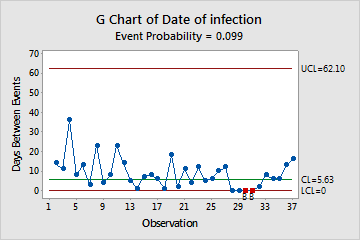In This Topic
Step 1: Determine whether the occurrence of rare events is stable and in control
The G chart plots the number of opportunities between events or the days between rare events so you can easily detect when events occur more often than expected. The center line is the 50th percentile of the distribution. The upper control limit indicates the amount of expected variation in the process. The lower control limit is always set at 0 on the G chart.
Red points indicate subgroups that fail at least one of the tests for special causes and are not in control. If the same point fails multiple tests, then the point is labeled with the lowest test number to avoid cluttering the graph. If the chart shows out-of-control points, investigate those points. When a point on a G chart fails the Benneyan test, the point is denoted with B.
Out-of-control points can influence the estimates of process parameters and prevent control limits from truly representing your process. If out-of-control points are due to special causes, then consider omitting these points from the calculations. For more information, go to Specify subgroups to estimate parameters for G Chart.
In these results, four points in a row are 0, indicating that infections occurred on the same day several days in a row. When you hold the pointer over a red point, you can get more information about this point.

Step 2: Identify which points failed each test
Investigate any points that failed the tests for special causes. By default, Minitab conducts Test 1, Test 2, and the Benneyan test. When you conduct multiple tests, points can fail multiple tests. The output shows exactly which points failed each test, as shown here.
Note
When you use several tests at the same time, the sensitivity of the chart increases. However, the false alarm rate also increases, which can make you react to the test results unnecessarily.
For more information on each of the tests and when to use them, go to Using tests for special causes in control charts.
